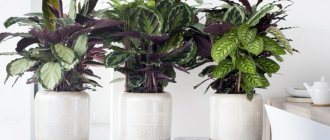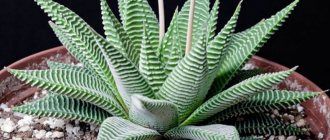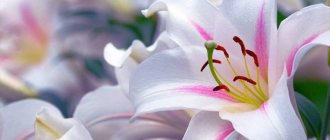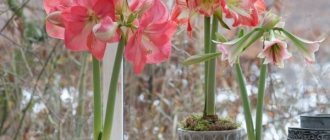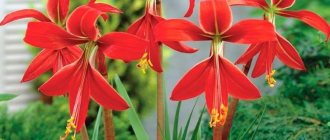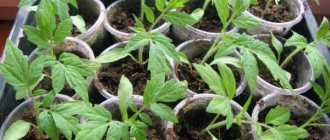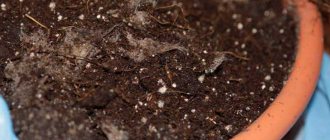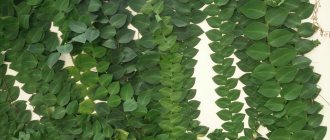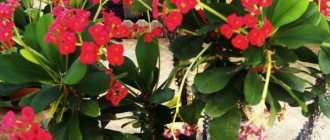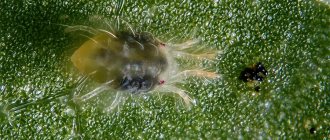Echeveria belongs to the Crassulaceae family and is widely distributed in nature in the plains and mountainous regions of Mexico and America. People also call it young cabbage, hare cabbage and stone rose. Indeed, the resemblance to a rose is simply amazing: juicy petals of the most varied colors form a rosette, reminiscent of everyone’s favorite flower. There are numerous signs and superstitions associated with the stone rose, which will be discussed in this article.
In the Middle Ages, young trees thickly covered the roofs of houses. It was believed that they were able to protect buildings from lightning strikes. Allegedly, Charlemagne himself firmly believed in this and forced his subjects to follow his command. It is thanks to this belief that the plant variety Roofing has survived to this day, which is distinguished by the most varied colors of leaves and a large, dense peduncle consisting of 40–100 flowers. Today, hare cabbage can no longer be found on the roofs of houses, but it is widely used in landscape design, in particular, decorating paths and borders, creating alpine slides, etc.
The plant is quite unpretentious to soil quality and ambient temperature, but some varieties are still recommended to be brought indoors for the winter. In this regard, many are interested in whether it is possible to keep a stone rose at home, because the signs regarding this are generally unfavorable. It is believed that juveniles are a cemetery flower and are completely unsuitable for growing at home. Here everything will depend on how the person himself relates to these superstitions, because not only young flowers are grown on graves, but also tulips and daffodils, which no one considers to be cemetery flowers. The tulip has been considered a symbol of International Women's Day for several decades.
This flower is widely used not only for landscaping, but also for office decoration, because it fits perfectly into any minimalist interior and does not require special care. It is not watered often, and there is no need to select the optimal direction of light - the plant feels great under the sun. All the negative signs about the stone rose in the house are completely unfounded, because it is even included in wedding bouquets, and in organizing such an event, everything, every little thing matters. Therefore, you should not be afraid of anything and try to plant this beautiful unusual flower on your windowsill, which will delight the eye at any time of the year.
Many people like the stone rose - signs and superstitions associated with echeveria will help you figure out whether it is worth keeping this plant in your home.
Wonderful plant Echeveria
This plant is distributed mainly in America and Mexico, growing on plains or mountain deserts. In the territory of central Russia and the Caucasus there are species of echeveria. Echeveria has received many names among the people: stone rose, hare cabbage, young, tenacious.
Photo of stone rose
The comparison with a rose or cabbage is not accidental, because if you look at the appearance of the plant, you will understand that it resembles both a rosebud and white cabbage.
The plants are used as decoration; often in folk medicine, certain types of juvenilia are used to treat fever, epilepsy and various other diseases. In ancient times, girls believed that it could be used to remove freckles and age spots.
Botanical description
Echeveria has a number of botanical features that distinguish it from other succulents:
- complete absence or presence of a stem with a height of 5 to 70 cm (depending on the type);
- the presence of creeping shoots (in some species);
- root system - superficial or filamentous;
- high density and saturation of leaves with moisture;
- leaf shape – oval, with a pointed tip;
- leaf plate dimensions: width up to 15 cm, length up to 30 cm;
- a rosette of collected leaves (dense or loose) is distinguished by its splendor and has an external resemblance to a rose or lotus;
- the color of the leaves is varied: purple-pink, scarlet, all palettes of green, burgundy, gray with a blue tint;
- the presence of pubescence or coating on the leaf blades, reminiscent of frozen wax;
- peduncle length – up to 50 cm;
- flowers are small (up to 30 mm) five-membered bells forming erect inflorescences;
- the color of the petals is determined by the level of illumination: in dim light they have a yellow tint, in bright light they have a red-orange tint;
- flowering period - no more than one month (in spring or summer).
Sometimes babies form on the peduncle, which can be transplanted into a separate pot.
READ ABOUT OTHER SUCCULENTS: GASTERIA, COTYLEDON, GRASSWAY, LITHOPS, REJUVEN, SEDUM, a href=”https://botanicoved.com/komnatnye/sukkulenty/raznovidnosti-sukkulenty/pahifitum.html” rel=”noopener” target=”_blank ”>PACHYPHYTUUM, PORTULACARIA, SEDEVERIA, STAPELIA, HAVORTIA, EONIUM.
Signs about indoor stone rose
In the Ancient Roman Empire, the stone rose was considered endowed with special magical powers. She was credited with the ability to protect against black magic.
The plant turned out to be really tenacious. It can grow in mountains, crevices, on sand and clay, practically does not need moisture, and can tolerate heat and frost. The young will survive in any weather conditions. That is why the plant, capable of surviving in any situation, protecting from evil spirits, thunder and lightning, has long been considered a protector, a good talisman.
Another common superstition is that the stone rose is a cemetery flower, unfavorable, charged with negative energy. Therefore, many people refuse to keep it in their homes. As you can see, this opinion differs from the above. And in cemeteries it is planted only because of its ability to survive without long-term watering.
Negative superstitions
Reference! Previously, they planted beautiful echeveria on graves , believing that it would cleanse the dead and help them get to heaven faster. The plant supposedly brings peace to the dead.
The most unpretentious plant is really very convenient to plant on graves, because it does not require care, watering, and is an excellent decoration.
Because of this, some people are afraid to keep this wonderful young thing at home. Old prejudices are becoming a thing of the past, and the benefits of echeveria have long been proven by experts.
Opinion of psychics and bioenergetics
Psychics and bioenergetics experts agree that, in general, this plant does not attract bad luck and does not harm the owner of the room.
You should not be afraid of the superstition that says that young people have cemetery energy, since there is no confirmation of such an opinion, and it is unlikely that such a terrible attribute would have been used then for so many years as a talisman against evil forces and bad weather.
Of course, it is very important how you feel about this flower. If you are afraid of it, doubt that it is filled with positive energy, will have a good influence on your life, and will not cause damage, then the result will be appropriate.
It does not matter at all in which part of the apartment the stone rose will be located, since the flower has completely neutral energy. Of course, if you love this plant, talk to it, fill it with your positive energy, then it will be able to increase it several times.
In addition, if you believe that the stone rose is your reliable talisman against any adversity and black magic, then it will be so.
As you can see, the stone rose is a neutral plant, and you can have it in your home without fear. Don't be afraid, don't think about the bad superstitions associated with this flower. After all, if you like him and doesn’t cause any negative emotions, then he won’t bring any negativity into your life.
Echeveria (Echeveria) is capable of creating interspecific and intergeneric hybrids, for example pachyveria (XPachyveria), sediveria (XSediveria), graptoveria (XGraptoveria).
Echeveria (echeveria) is named after a 19th century Mexican artist. Atanasio Echeverria, who illustrated books on the flora of Mexico.
Representatives of the genus Echeveria (echeveria) are succulents, stemless, perennial, herbaceous, low-growing plants, sometimes subshrubs with a short branched fleshy trunk.
The leaves are arranged very densely, spirally, form a rosette, entire edges, more or less fleshy, flat to rounded, green, covered with a grayish-white bloom, somewhat reddening.
The leaves are arranged very densely, spirally, form a rosette, entire edges, more or less fleshy, flat to round, green. Sometimes a reddish coating can be seen along the edge of the leaf blade.
Different types of echeveria have different protective covering: some have a waxy grayish-white coating, others have pubescence. This helps the plant protect itself from direct sunlight. The peduncle is 30-90 cm long, axillary, sometimes branched, racemose, or the flowers are umbellate. The flowers are numerous.
Signs associated with the cemetery
In fact, the custom of planting thickets of stone flowers in a cemetery began only because of the persistent properties of the planting. Its species is not afraid of rain, drought, or weeds. For graves that are not typically visited often, this plant is an ideal way to maintain a dignified burial appearance without constant disturbance. In addition, the same superstition comes into play again: the flower protects against evil spirits. Therefore, the deceased will be under even greater protection.
However, people are subject to unreasonable fears, which is why a stone rose in a pot at home is suddenly associated with bad things. Meanwhile, the only sign that a stone rose is blooming in a home or garden indicates that this place is truly bright and protected from the influence of darkness.
These are the signs about echeveria, and their essence suggests the need for choice. But only when there are doubts about faith. In this case, it is better to refuse the flower. If there are bright thoughts in your soul, the plant will respond to them with a real miracle.
Watering and air humidity.
Echeverias (echeverias) are watered sparingly in spring and summer. Between waterings, the earthen ball should dry out completely. Plants cannot tolerate excess moisture. In extreme heat, on a sunny windowsill, echeveria (echeveria) leaves may wrinkle, which means the plant should be watered.
In the autumn-winter period, watering is extremely rare (especially when the plant is kept in cool conditions).
When keeping echeveria (echeveria) in winter under normal (18-20°C) temperature conditions, it may be necessary to water the plants a little more often. The signal for watering is when the leaves wilt.
Water with soft, well-settled water. When watering, you need to make sure that water does not get on the rosettes of leaves - this can cause them to rot, and in bright sunshine they can get burned. It makes sense to use bottom watering.
Read the continuation on the next page by clicking its number below.
Air humidity does not play a significant role for echeveria. The plant can tolerate dry air well and does not need spraying. Moreover, spraying may deteriorate the appearance of the plant.
Appearance and description of the plant
Large, fleshy, star-shaped leaves are the main characteristic of young
Juvenile is a perennial fleshy herb with pubescent glandular hairs (sometimes there are completely naked varieties). The plant forms very dense rosettes consisting of many leaves. The leaves themselves are quite thick and succulent. Their shape is usually ovoid, less often oblong.
The flowers are sepals and petals fused at the base, numbering from 8 to 20. The petals are slightly longer than the sepals, they are star-shaped. There are always twice as many stamens as petals (from 16 to 40). Flowers are always collected in panicle-type inflorescences. The young blooms in early or mid-summer.
The root system is dense, consisting of several rhizomes connected to each other by underground lateral shoots - stolons. Thanks to the stolons growing in different directions, the young are able to cover large areas.
The species diversity of the juveniles is very large. More than 500 species of this plant have been described, differing from each other in the shape of leaves, rosettes, and flowers. Each type has its own unique shade. Of these species, about 50 are perfectly adapted to life in temperate climatic conditions in the CIS.
The species diversity of juveniles is shown in the photo below:
Species diversity was young
But, of course, most types of stone rose are indoor ornamental plants. They are thermophilic and in our climate can be grown exclusively at home.
Some types of indoor rock roses can also be grown in open ground, but they become significantly smaller, and in addition, if the winters are too harsh, they can freeze out. Therefore, when choosing plants for garden landscape design, you should know exactly their growing characteristics.
How to create beautiful flower beds and flower beds at your dacha with your own hands? (220 fresh photos and video ideas) + Reviews
Rest period.
From October to February. Plants are kept in a place with bright light, in cool conditions. Water very rarely, as needed (when the leaves wither).
In the spring-summer period, feed once a month with fertilizers for cacti of low concentration. Fertilizing with a weak solution of mineral fertilizers is done with caution. Excess fertilizer has a negative effect on the appearance of the plant. The use of fertilizer with a high nitrogen content is not permissible. In autumn and winter, the plant is not fed.
Echeverias (echeverias) are short-day plants, but they respond to changes in day length; therefore, by adjusting the length of the day, it is possible to change the flowering time.
The most favorable conditions for the formation of flowers are a temperature of 15-18°C and a short day - 12-13 hours for 50 days.
How to propagate and replant a flower at home
Flower growers note that this variety is quite difficult to propagate at home and it is not always possible to plant a flower, but they note several basic methods of propagation that are still worth trying.
Propagation by seeds
Using seeds to propagate a succulent is a labor-intensive process that is not always successful, and this should be taken into account when using this propagation method.
A brief algorithm of actions is as follows:
- Choose seeds from the store or collect them from your succulent after flowering.
- Soak the seeds for a day in a weak solution of potassium permanganate to disinfect.
- Dry the seeds using a paper towel or sheet of paper.
- Prepare the soil and carefully sow the prepared seeds into it.
- Sprinkle them with a layer of sand on top, no more than 3 mm.
- Moisten the soil with settled water from a spray bottle.
- Cover the pot with transparent film and place it in a bright and warm place, regularly ventilate and moisten it.
- The first shoots will appear no earlier than after 3 weeks; when they appear, remove the film.
- Young sprouts should be planted after a few months, when they gain strength.
Reproduction.
Echeverias (echeverias) are easily propagated by leaves, cuttings, rosettes and seeds. Subshrubs are also propagated by the tips of their shoots.
Seeds are sown in late February early March. In a mixture of peat and sand (1+1). Maintain the temperature within 20-22°C, constantly spray and ventilate. Shoots appear in 12-14 days. When the seedlings grow up, they are planted in small containers with a substrate: leaf soil and sand (2:1). When the seedlings' rosette of leaves reaches 2-3 centimeters in diameter, they are transplanted into appropriate-sized pots with a mixture for adult plants.
Cuttings are planted in bowls, pots or sowing boxes. Before planting, the cuttings (and leaves) are slightly withered. Composition of soil for cuttings: clean sand or compost soil - 1 tsp, mixed with sand - 1 tsp. Cuttings root quickly.
Cuttings are taken in the spring - in March-May, but cuttings can be taken throughout the growing season. Rooted cuttings are planted one at a time in small pots (7 cm). For floral decoration, in the first year, small rosettes of leaves are cut from the roots, since after rooting they can be used for growing echeverias or other succulent plants in groups.
